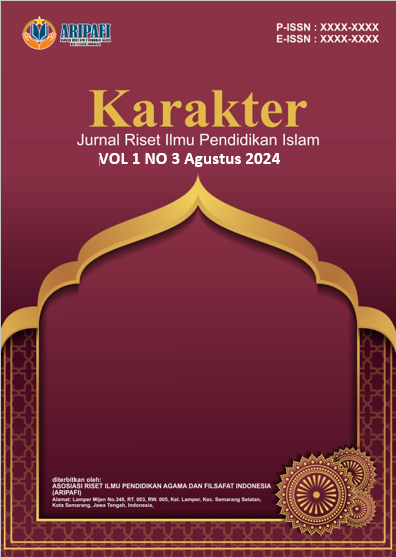Translanguaging dan Dampaknya Terhadap Pembelajaran Makna Kata (Frasa) Bahasa Arab pada Kelas PKPBA UIN Malang
DOI:
https://doi.org/10.61132/karakter.v1i4.151Keywords:
Translanguaging, Arabic Language, PKPBAAbstract
The purpose of this study is to analyze the phenomenon of translanguaging and its impact in the context of education, especially in teaching Arabic as a foreign language in the Special Program for Arabic Language Development (PKPBA) UIN Maulana Malik Ibrahim Malang. The methods used are literature study and observation to observe translanguaging (Indonesian, local language, and Arabic) that occurs in PKPBA. The results of the literature study revealed that translanguaging affects the performance of students with multilingual backgrounds (Indonesian, local languages, and Arabic). The result of the discussion in this article is that translanguaging always occurs in learning Arabic as a foreign language. Translanguaging is considered effective in learning at PKPBA, this is because translaguaging can increase student participation and activeness in learning. Recommendations for improvement include the development of multilingual learning materials, training for teachers, recognition of students' language diversity, further research on the impact of translanguaging, and the development of a more inclusive curriculum.
References
Adinolfi, L., & Astruc, L. (2017). An exploratory study of translanguaging practices in an online beginner-level foreign language classroom. Language Learning in Higher Education, 7(1), 185–204. https://doi.org/10.1515/cercles-2017-0008
Afriadi, R., & Hamzah. (2021). Exploring translanguaging practice in EFL classroom talk. In English Language and Literature International Conference (ELLiC) Proceedings. https://jurnal.unimus.ac.id/index.php/ELLIC/article/view/7393
Baker, C. (2011). Foundations of bilingual education and bilingualism. Multilingual Matters.
Chicherina, N. (2019). Multilingualism in the design of degree programmes: The case of Higher School of Economics. In Proceedings of the 2019 Conference (pp. 157–161). https://doi.org/10.2991/emssese-19.2019.24
Conteh, J. (2018). Translanguaging. ELT Journal, 72(4), 445–447. https://doi.org/10.1093/elt/ccy034
Emilia, E., & Hamied, F. A. (n.d.). Translanguaging practices in a tertiary EFL context in Indonesia. ProQuest. Retrieved December 7, 2023, from https://www.proquest.com/openview/2916399d019bd5905203a4eef43d72ae/1?pq-origsite=gscholar&cbl=2034497
García, O., & Wei, L. (2014). Translanguaging. Palgrave Macmillan UK. https://doi.org/10.1057/9781137385765
Hadi, N. (2018). Analisis isi buku ajar bahasa Arab (pendekatan saintifik kurikulum 2013) kelas I madrasah ibtidaiyah terbitan Kementerian Agama Republik Indonesia 2014. Ijaz Arabi Journal of Arabic Learning. https://ejournal.uin-malang.ac.id/index.php/ijazarabi/article/view/4930
Hidayatullah, M. S., & Mardiyah. (2022). Studi komparasi KMA No. 183 tahun 2019 dengan KMA No. 165 tahun 2014 tentang pedoman kurikulum 2013 materi PAI dan bahasa Arab. CENDEKIA: Jurnal Ilmu Pengetahuan. https://jurnalp4i.com/index.php/cendekia/article/view/836
Rasman. (2018). To translanguage or not to translanguage? The multilingual practice in an Indonesian EFL classroom. Indonesian Journal of Applied Linguistics, 7(3).
Rasmin, L. O., & Nur, S. (2023). Translanguaging in EFL classroom and its impact on student’s performance at a secondary school level: A systematic review. EJI (English Journal of Indragiri): Studies in Education, Literature, and Linguistics, 7(1), Article 1. https://doi.org/10.32520/eji.v7i1.2162
Rerung, M. K. T. (2017). Evaluating translanguaging practices in bilingual classrooms. Journal of English Language and Culture, 5(2), Article 2. https://doi.org/10.30813/jelc.v5i2.280
San Isidro-Smith, X. (2019). The multi-faceted effects of CLIL: A literature review. Nexus Aedean Journal, 2019(1).
Vogel, S., & García, O. (2017). Translanguaging. CUNY Academic Works. https://academicworks.cuny.edu/gc_pubs/402/
Yan, S., & Zhang, L. (2023). Trends and hot topics in linguistics studies from 2011 to 2021: A bibliometric analysis of highly cited papers. Frontiers in Psychology, 13. https://www.frontiersin.org/articles/10.3389/fpsyg.2022.1052586
Yuvayavan, F. (2019). Translanguaging in EFL classrooms: Teachers’ perceptions and practices. Journal of Language and Linguistic Studies. https://dergipark.org.tr/en/pub/jlls/issue/46758/586811
Zein, S. (2019). Translanguaging in the EYL classroom as a metadiscursive practice. In Title of the Book (pp. Page Range). https://www.taylorfrancis.com/chapters/edit/10.4324/9781315105680-3/translanguaging-eyl-classroom-metadiscursive-practice-subhan-zein






